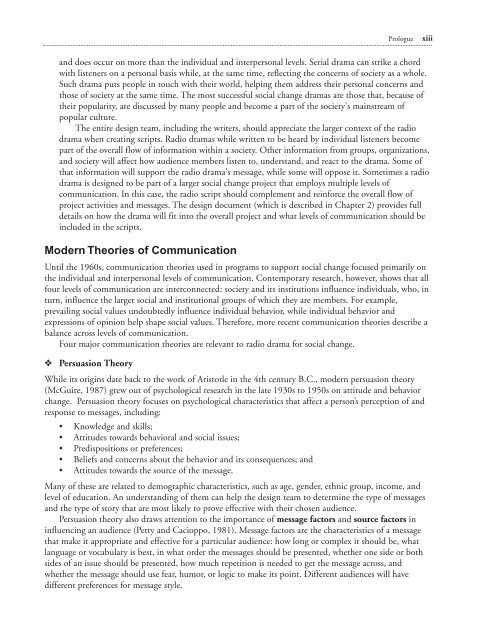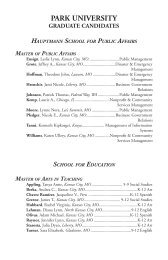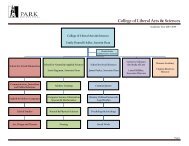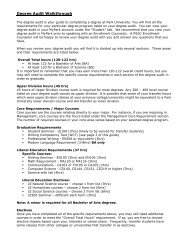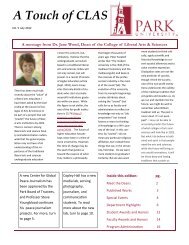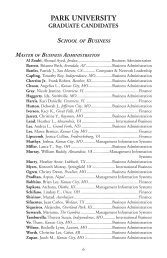How to Write a Radio Serial Drama for Social Development- PDF
How to Write a Radio Serial Drama for Social Development- PDF
How to Write a Radio Serial Drama for Social Development- PDF
Create successful ePaper yourself
Turn your PDF publications into a flip-book with our unique Google optimized e-Paper software.
Prologue<br />
xiii<br />
and does occur on more than the individual and interpersonal levels. <strong>Serial</strong> drama can strike a chord<br />
with listeners on a personal basis while, at the same time, reflecting the concerns of society as a whole.<br />
Such drama puts people in <strong>to</strong>uch with their world, helping them address their personal concerns and<br />
those of society at the same time. The most successful social change dramas are those that, because of<br />
their popularity, are discussed by many people and become a part of the society's mainstream of<br />
popular culture.<br />
The entire design team, including the writers, should appreciate the larger context of the radio<br />
drama when creating scripts. <strong>Radio</strong> dramas while written <strong>to</strong> be heard by individual listeners become<br />
part of the overall flow of in<strong>for</strong>mation within a society. Other in<strong>for</strong>mation from groups, organizations,<br />
and society will affect how audience members listen <strong>to</strong>, understand, and react <strong>to</strong> the drama. Some of<br />
that in<strong>for</strong>mation will support the radio drama's message, while some will oppose it. Sometimes a radio<br />
drama is designed <strong>to</strong> be part of a larger social change project that employs multiple levels of<br />
communication. In this case, the radio script should complement and rein<strong>for</strong>ce the overall flow of<br />
project activities and messages. The design document (which is described in Chapter 2) provides full<br />
details on how the drama will fit in<strong>to</strong> the overall project and what levels of communication should be<br />
included in the scripts.<br />
Modern Theories of Communication<br />
Until the 1960s, communication theories used in programs <strong>to</strong> support social change focused primarily on<br />
the individual and interpersonal levels of communication. Contemporary research, however, shows that all<br />
four levels of communication are interconnected: society and its institutions influence individuals, who, in<br />
turn, influence the larger social and institutional groups of which they are members. For example,<br />
prevailing social values undoubtedly influence individual behavior, while individual behavior and<br />
expressions of opinion help shape social values. There<strong>for</strong>e, more recent communication theories describe a<br />
balance across levels of communication.<br />
Four major communication theories are relevant <strong>to</strong> radio drama <strong>for</strong> social change.<br />
❖ Persuasion Theory<br />
While its origins date back <strong>to</strong> the work of Aris<strong>to</strong>tle in the 4th century B.C., modern persuasion theory<br />
(McGuire, 1987) grew out of psychological research in the late 1930s <strong>to</strong> 1950s on attitude and behavior<br />
change. Persuasion theory focuses on psychological characteristics that affect a person’s perception of and<br />
response <strong>to</strong> messages, including:<br />
• Knowledge and skills;<br />
• Attitudes <strong>to</strong>wards behavioral and social issues;<br />
• Predispositions or preferences;<br />
• Beliefs and concerns about the behavior and its consequences; and<br />
• Attitudes <strong>to</strong>wards the source of the message.<br />
Many of these are related <strong>to</strong> demographic characteristics, such as age, gender, ethnic group, income, and<br />
level of education. An understanding of them can help the design team <strong>to</strong> determine the type of messages<br />
and the type of s<strong>to</strong>ry that are most likely <strong>to</strong> prove effective with their chosen audience.<br />
Persuasion theory also draws attention <strong>to</strong> the importance of message fac<strong>to</strong>rs and source fac<strong>to</strong>rs in<br />
influencing an audience (Petty and Cacioppo, 1981). Message fac<strong>to</strong>rs are the characteristics of a message<br />
that make it appropriate and effective <strong>for</strong> a particular audience: how long or complex it should be, what<br />
language or vocabulary is best, in what order the messages should be presented, whether one side or both<br />
sides of an issue should be presented, how much repetition is needed <strong>to</strong> get the message across, and<br />
whether the message should use fear, humor, or logic <strong>to</strong> make its point. Different audiences will have<br />
different preferences <strong>for</strong> message style.


